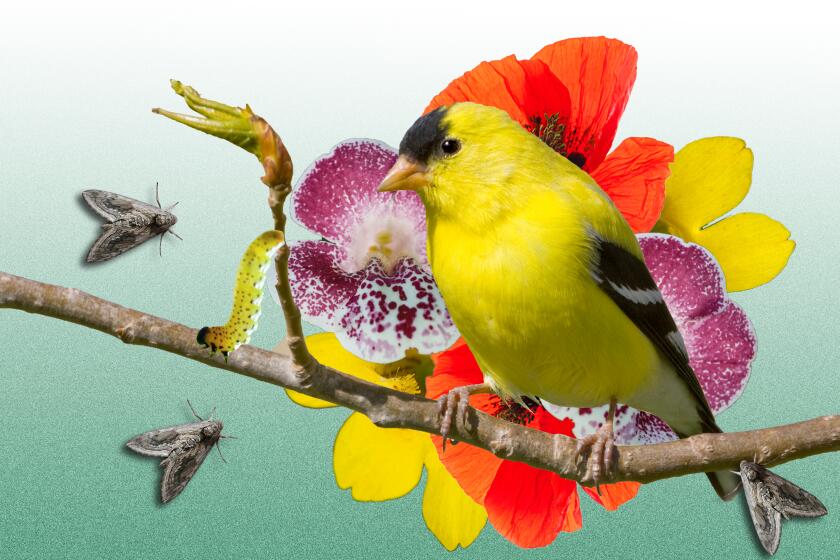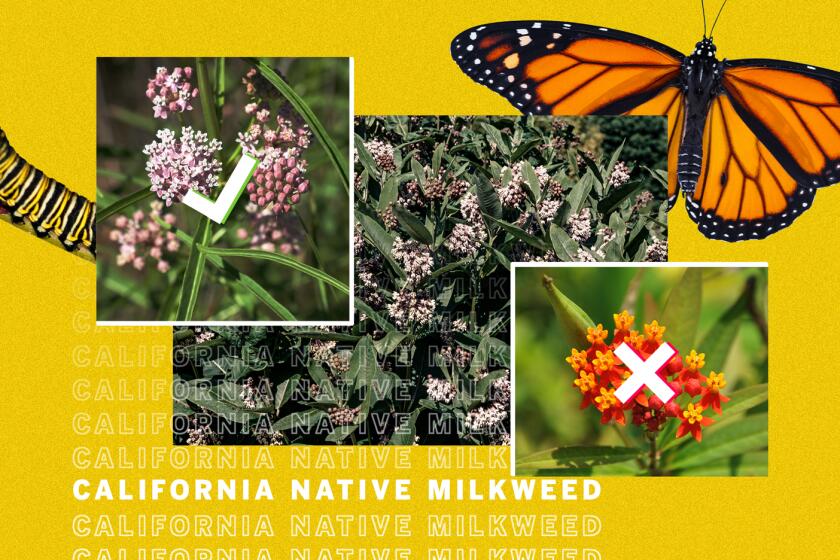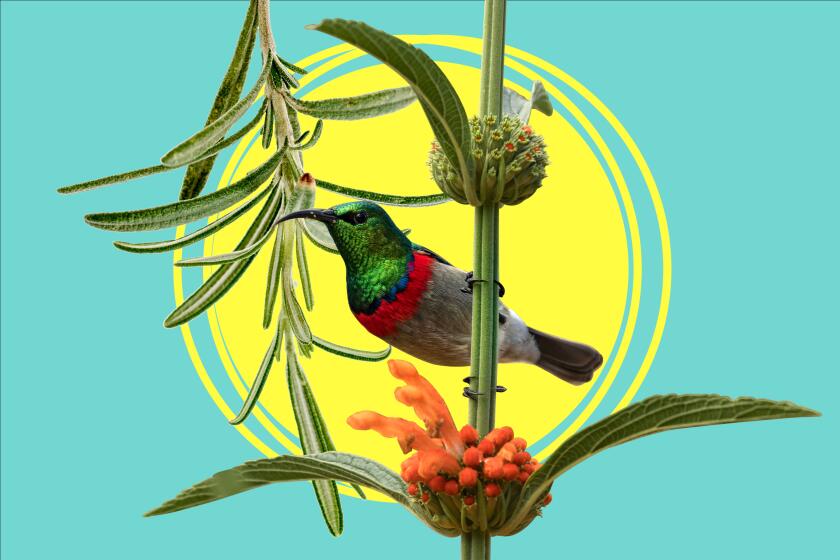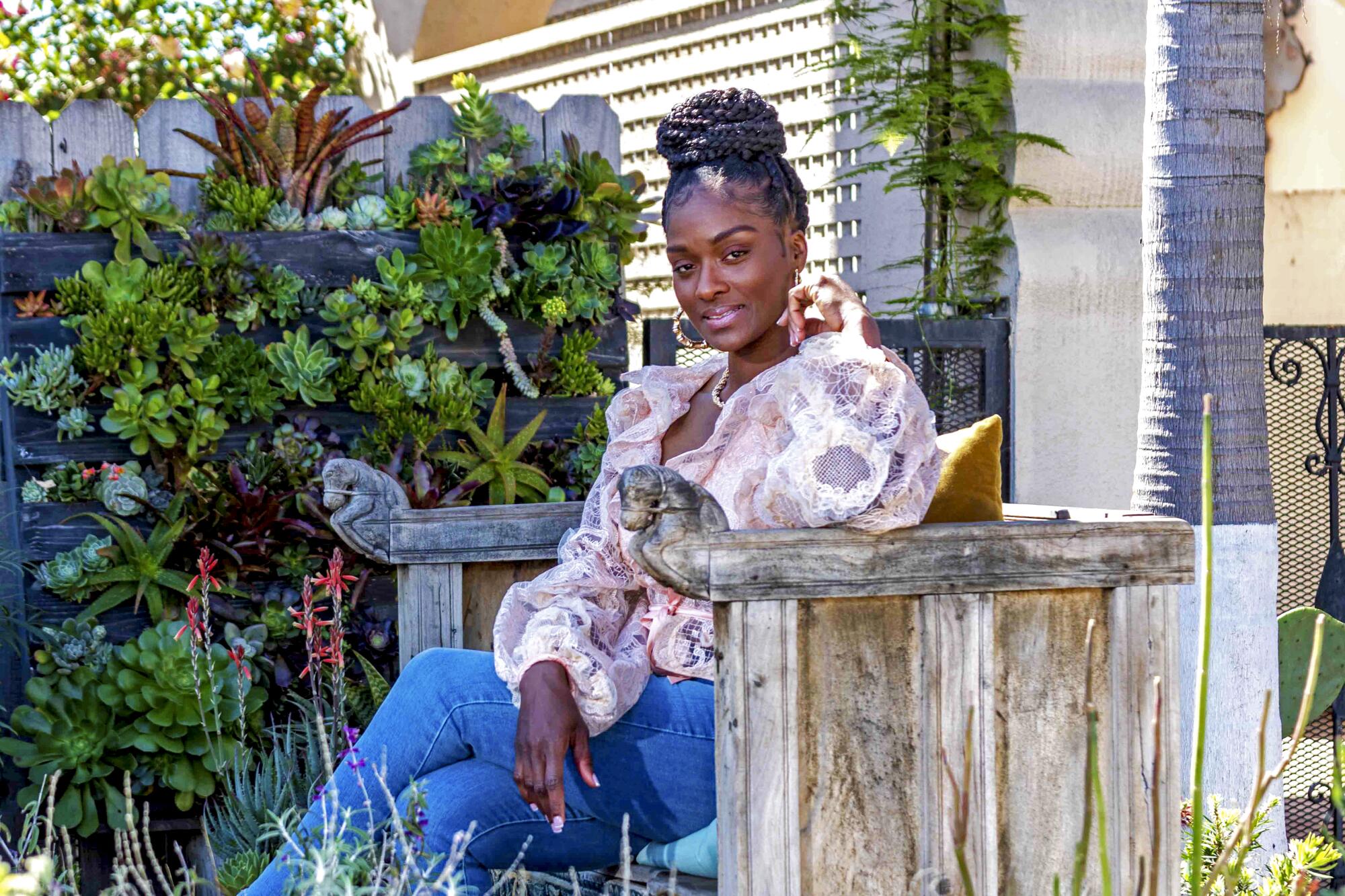
This is the latest in a series we call Plant PPL, where we interview people of color in the plant world. If you have any suggestions for PPL to include in our series, tag us on Instagram @latimesplants.
Brandy Williams’ business is landscape design, but it’s more accurate to think of her as an artist who paints for pollinators, primarily with succulents and what she calls “California friendly” plants.
Williams never consciously intended to make plants her life’s work. In college, the Compton native thought about majoring in accounting or teaching, finally settling on human resources. But when it came to a project for her master’s degree, she found herself creating a program around gardening — specifically creating a pollinator garden at Augustus F. Hawkins High School in the Vermont-Slauson neighborhood of South L.A. — and it was as if someone had opened a door to her true profession.
“I had been working with plants with my grandmother ever since I was young,” Williams said. “She taught me how to keep a garden clean and be resourceful. But I had no idea I would make it my work until this project in 2014. That’s when I learned who I was. Plants gave me the freedom to create.”
Eight years later, her business, Garden Butterfly, is creating landscapes at private homes and businesses around Los Angeles. Her specialty is designing gardens laced with succulents of every size, California natives and other noninvasive plants fit for a Mediterranean climate. Her studio “lab” is the front yard of her 1930s Storybook-style home in Vermont Knolls.
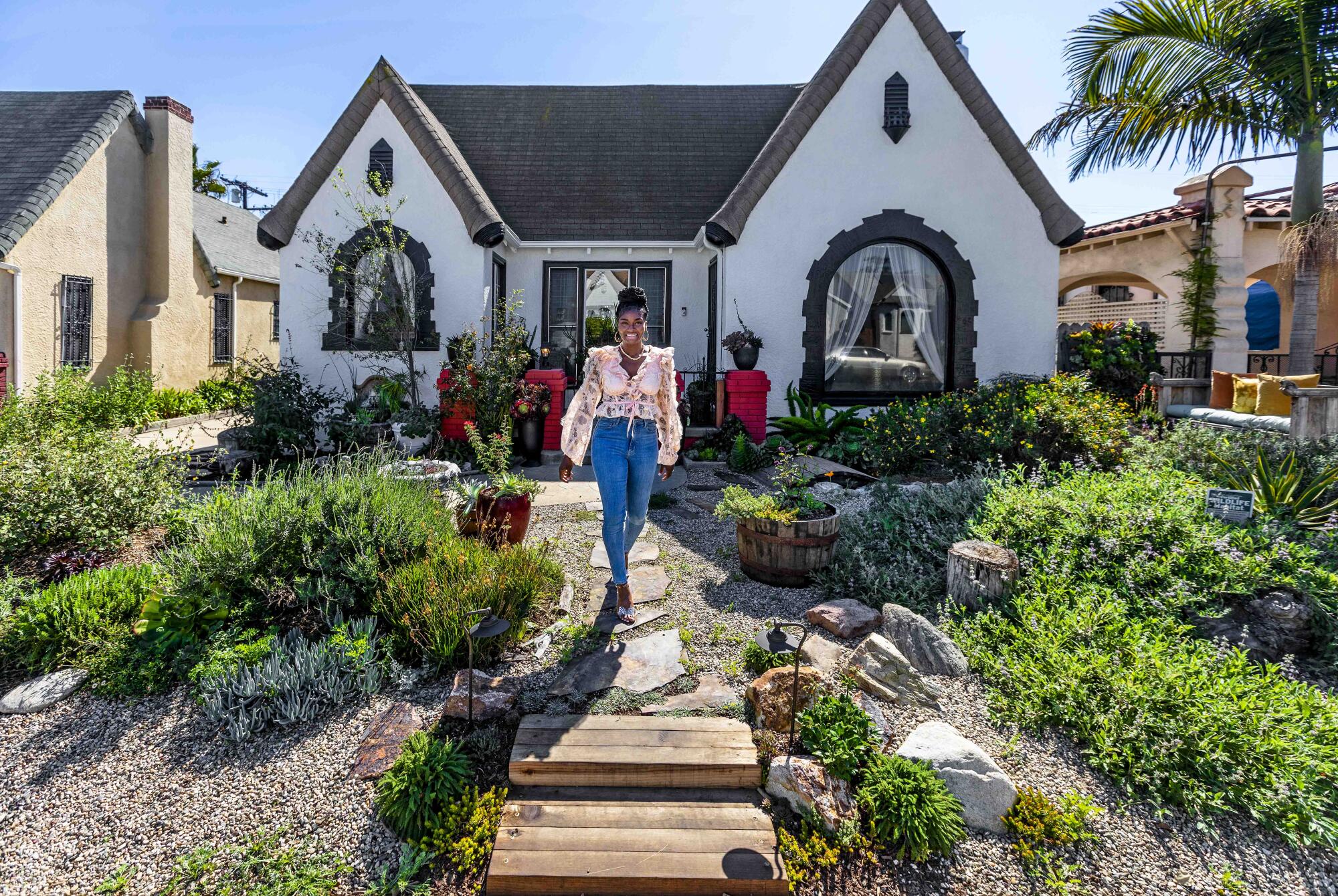
The 900-square-foot yard was just lawn and vintage walkway when she and her family moved in seven years ago. She got help removing the old grass and then started creating.
The result is so lovely that the Theodore Payne Foundation has made it part of its 2022 Native Plant Garden Tour on April 23-24. It will feature extraordinary landscapes where at least 50% of the plants are natives of California.
“Every year, Brandy hosts a tour for her neighborhood, and she invited us last year, and we were blown away by her style and skill,” says Evan Meyer, the foundation’s executive director. “So when we went about deciding who should be featured in the [2022] tour, she was right at the top of the list.”
Williams’ landscape “canvas” is relatively small but lushly filled with 20 varieties of California native plants — salvias, ceanothus, buckwheats, mallows and such perennials as monkey flower and yarrow. Stone pavers float on a pea gravel path littered with the feathery leaves of California poppies and other emerging wildflowers. Interlaced among the plants are large rocks, half-buried logs (to provide shelter and breeding grounds for insects and animals) and a National Wildlife Federation sign designating the area as a certified wildlife habitat.
Tour gardens filled with native plants
Being a habitat requires a water source too, so Williams installed a fountain against the house, half hidden by pots of reeds and the long graceful branches of a Waverly sage, its constant burble a soothing garden song. Huge aeoniums — sort of the succulent version of a sunflower — and flapjack kalanchoe share space with seaside daisies and the long-stemmed purple flowers of lavender and Mexican sage. More succulents spill from pots along the porch and side of the house — creamy green burro’s tail (Sedum morganianum) paired with ruffled echeverias or aloes. Tiny rosettes of sempervivum succulents are nestled against mounds of lemon thyme and nearby, a silver green dudleya shares a pot with the aptly named red fairy duster (Calliandra californica), whose flowers look like a wispy vegetable brush.
At the corner of the yard, next to the house, Williams has built a small deck nearly covered by a large bench, where you can study a pallet-turned-planter brimming with succulents or watch hummingbirds flit over mounds of blooming lavender and sage to perch across the garden on the gangly Mexican succulent with reddish blooms known as tall slipper plant (Pedilanthus bracteatus).
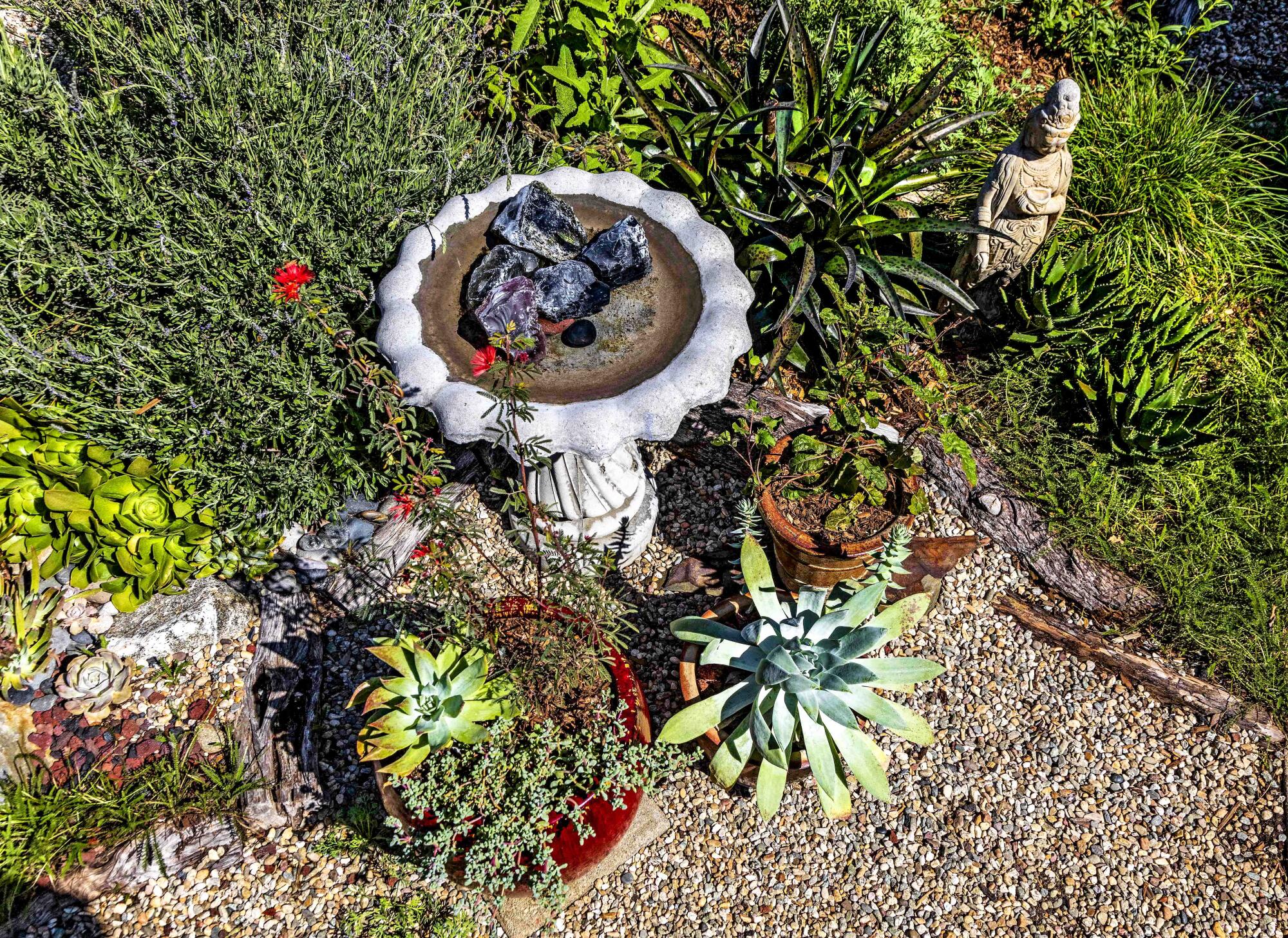
It’s easy to be transported in this artfully arranged space, and like many artists, Williams sees her medium as a way to communicate with the world. Her website features a quote from agriculture scientist George Washington Carver, the first African American to earn a bachelor’s of science degree, whose innovative research and inventions at Tuskegee University helped Southern farmers restore their depleted soil: “I love to think of nature as an unlimited broadcasting station, through which God speaks to us every hour, if we will only tune in.”
That quote resonates in part because “plants have always talked to me,” Williams said, but also because she so admires Carver’s style.
“This is the way nature communicates with you. It’s saying, ‘You got a meeting this morning? Slow down, it’s O.K. You’ve got this.’”
“Of course, he was connected to the Black community, but he worked for humanity in general, and he was respected by all,” she said. “And what he was saying with this quote I experienced just this morning, when I was out in the garden drinking coffee. The hummingbirds were flying around, I saw two monarch butterflies and the bees were all around me. He was saying this is the way nature communicates with you. It’s saying, ‘You got a meeting this morning? Slow down, it’s OK. You’ve got this.’”
Bird feeders are killing songbirds, due to a salmonella outbreak, but there are safer and better ways to attract birds to your garden space.
Williams, a slender, youthful mother of two college-age daughters, laughingly refuses to tell her age. For a photo shoot, she looks like a fashion model posing in a perfect prop garden wearing stilettos, but she laughs at the idea that this is her normal attire. At a job site, she says, she dresses in jeans, work boots and a flannel shirt, with a well-worn paint brush sticking out of her back pocket.
That brush is part of her grandmother’s legacy, the final touch when she’s planting her succulent gardens. She uses it to whisk dirt off the plants and tidy everything up.
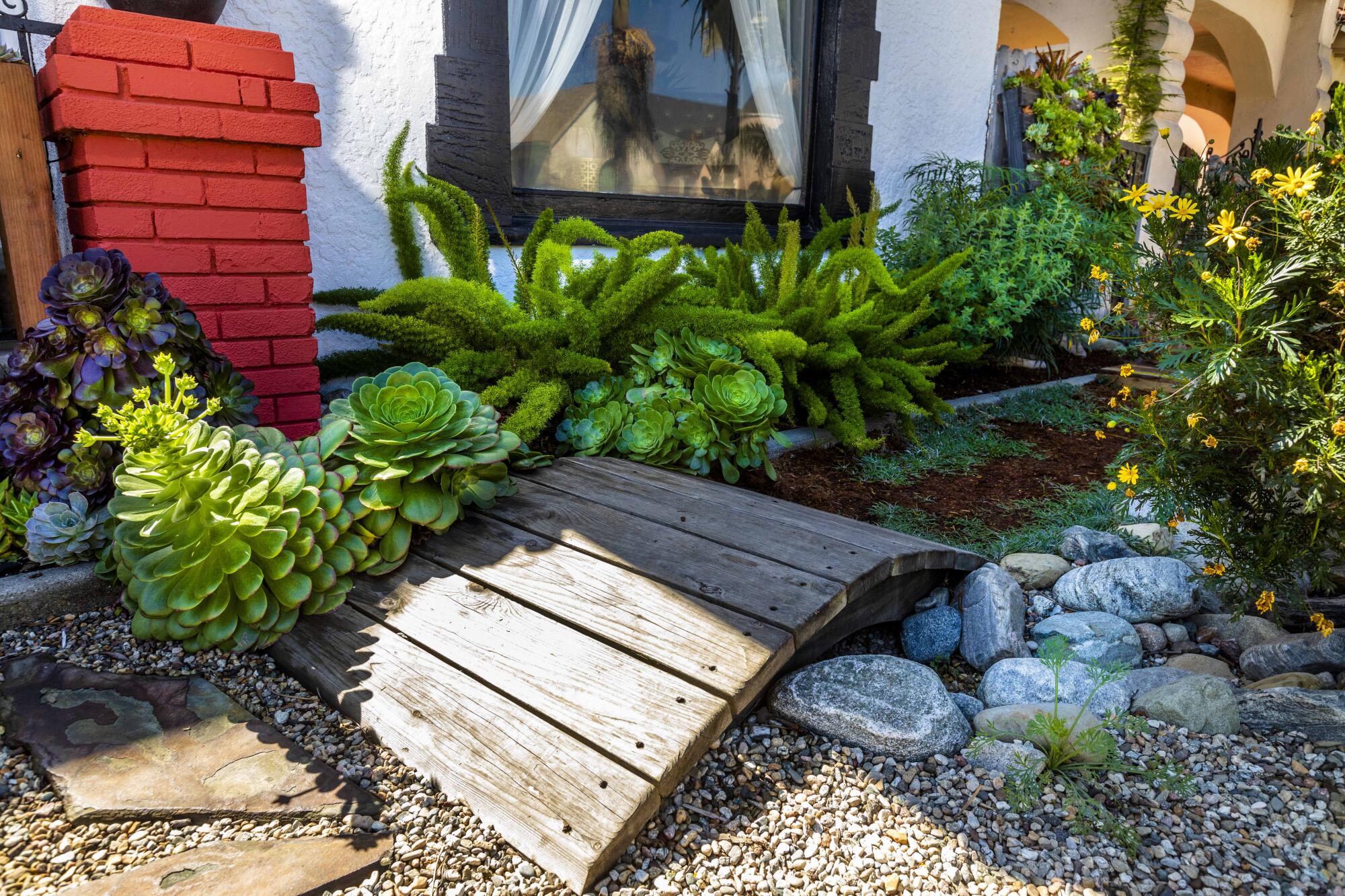
“She taught me that when you think of a garden, it should be swept and clean,” Williams said. “It’s a small task but a necessary one. Even with a little raised garden bed, even when you’re planning, you have to keep it organized.”
Williams shares more about her grandmother’s lessons, her landscaping inspirations and how she uses plants to build community below.
Her grandmother’s collard greens and purple grapes inspired her craft
“I always say there were many paths that led me here. I have always been interested in and appreciated plants, but growing up in Compton with my grandmother, I was really influenced by her life in general. She grew up on a farm in Arkansas, and she and my grandfather were part of the great migration of Blacks who left the segregated South to move north and west, looking for better opportunities and education. They came west and settled in Compton.
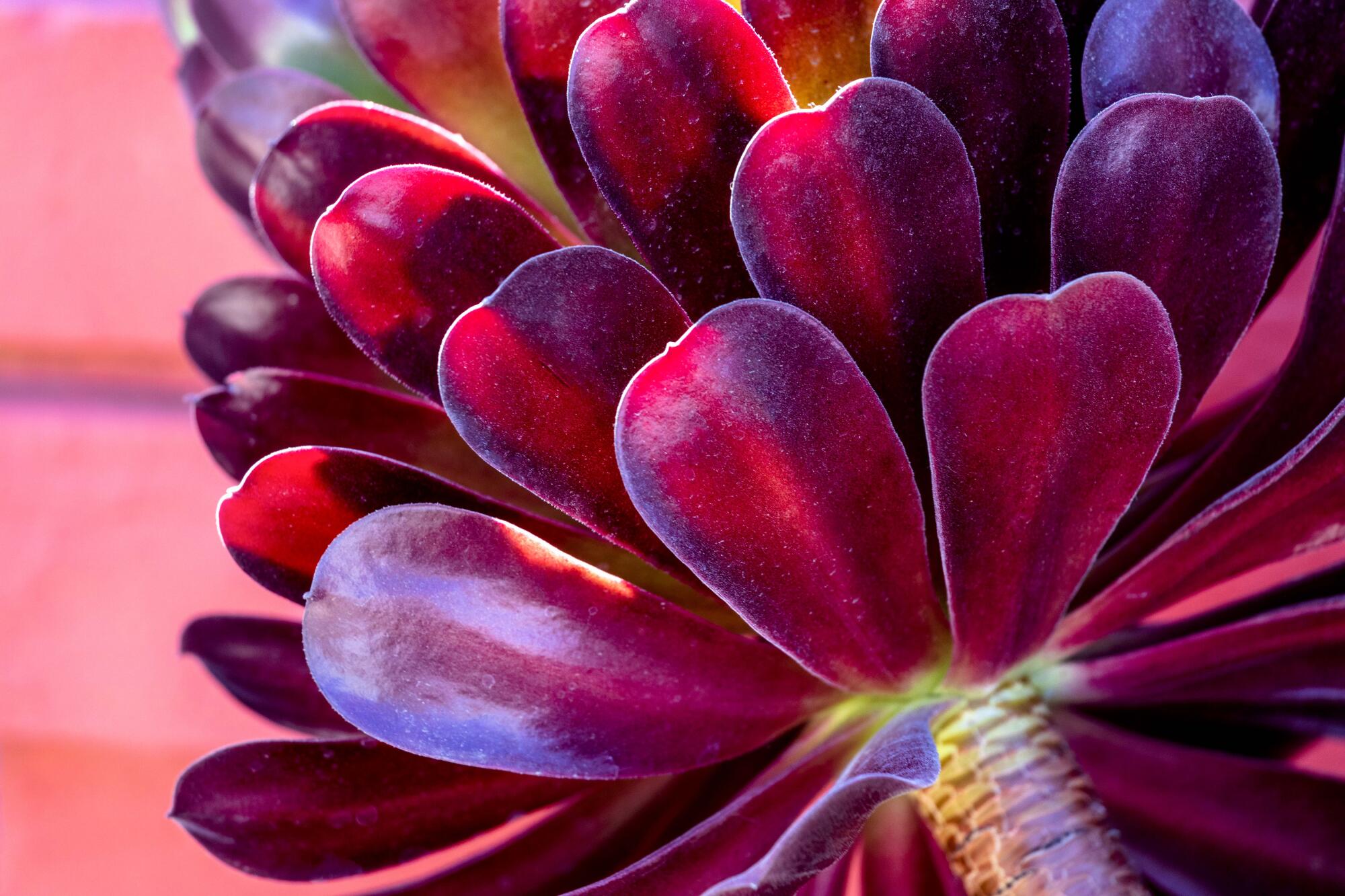
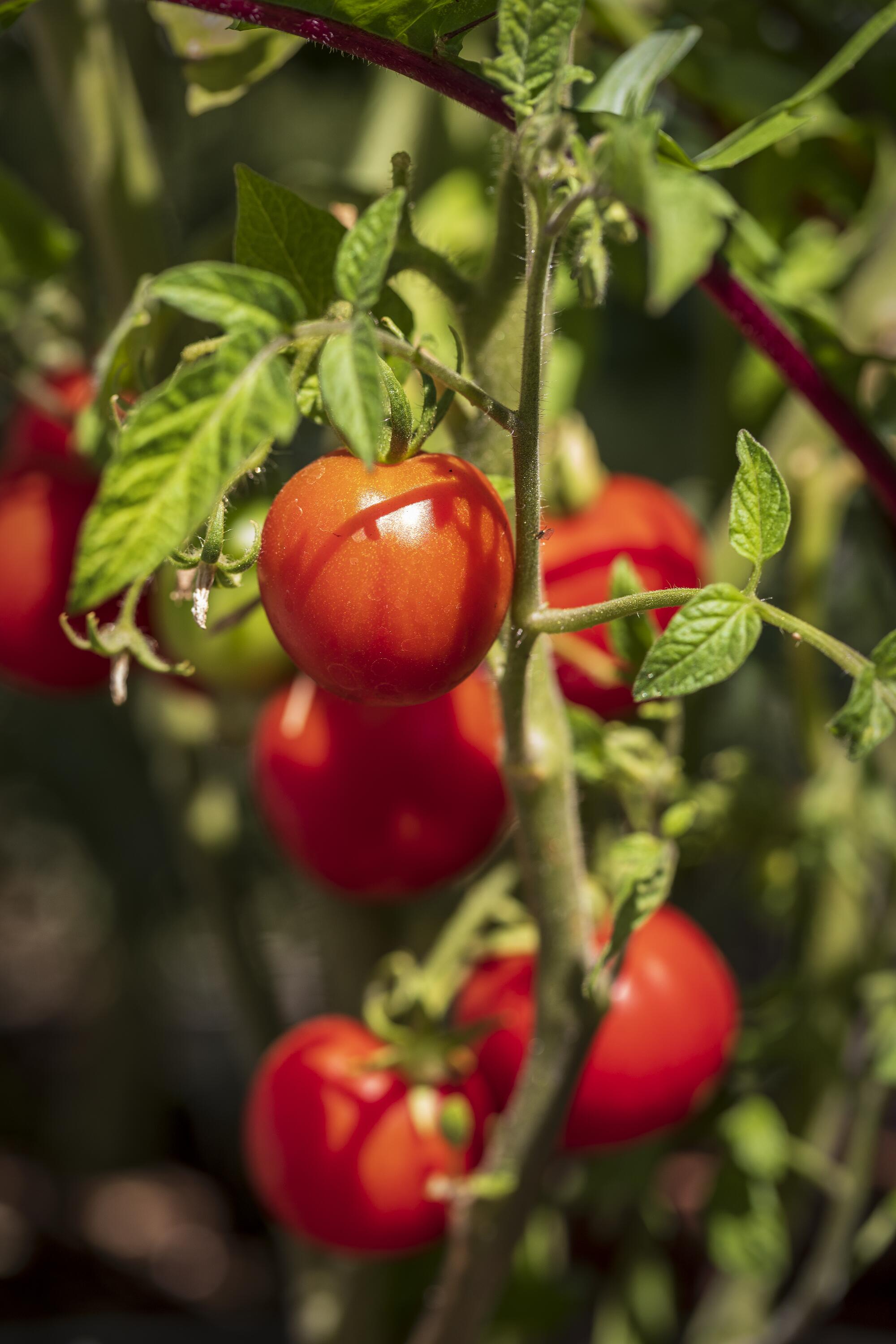
“My grandmother raised me, and I was required to work in the yard. I had to sweep and keep the garden clean and make sure the lawn was watered. I could not waste water — she got upset with me if I overwatered the lawn with the hose. But I didn’t mind doing the work. I just felt it was necessary, and I didn’t mind being outside. She had turf in the yard, a few succulents, a large lemon tree and a garden with collard greens and tomatoes and grapes growing along the gate. They were purple grapes and they tasted sour, but I thought it looked so cool. And that was my entry into all of this.
“Originally, when I went to school I was thinking about going into accounting and then I wanted to be a teacher, but life just had all these changes. ... I started out at Compton College, but I became a nontraditional college student. I earned my master’s degree online, years later. I was a stay-at-home mom for a while but my husband encouraged me to finish my degree in human resources. There are lots of different paths with human services — counseling, working with elders — but for my master’s degree, I decided to create lessons for creating pollinator gardens in schools. Augustus Hawkins High School asked me to help reestablish a garden they had created years earlier. They already had garden beds for food — fruits and vegetables — but my idea was to also grow plants that attract pollinators.
“I have a love for flowers and I always knew you needed pollinators [to get fruit], and growing up, whenever I saw a butterfly, I would stop in my tracks and be mesmerized. So I started researching. I learned about native plants through the Theodore Payne Foundation website — I took their certification program — and Las Pilitas Nursery in Santa Margarita. But I also did a lot of reading at the library. It’s like a field trip for me — some people go shopping, and I go to the Los Angeles Central Library downtown. I love the library.”
Obama persuaded her to save the bees
“That project [at the high school] was really my epiphany. I felt like I was led here [to landscaping] by a higher power, because once I got here, doors started to open for me.
“I wasn’t really focused on succulents or native plants at first. I knew I wanted to make plants my work, but then I read this presidential memorandum [from the Obama White House] in 2014, called ‘Creating a Federal Strategy to Promote the Health of Honey Bees and Other Pollinators.’ I read the whole thing, because that’s the way I am — I study and read. I thought, ‘I was able to establish a garden for butterflies even though I have a master’s in human services because I’m creative and I have an open mind.’ The memo encouraged businesses to incorporate plants for pollinators, and there was something about how you can do it on a small scale, and I was like, ‘Yeah, this is what I want to do. I want to branch out with pollinator-friendly landscaping.’
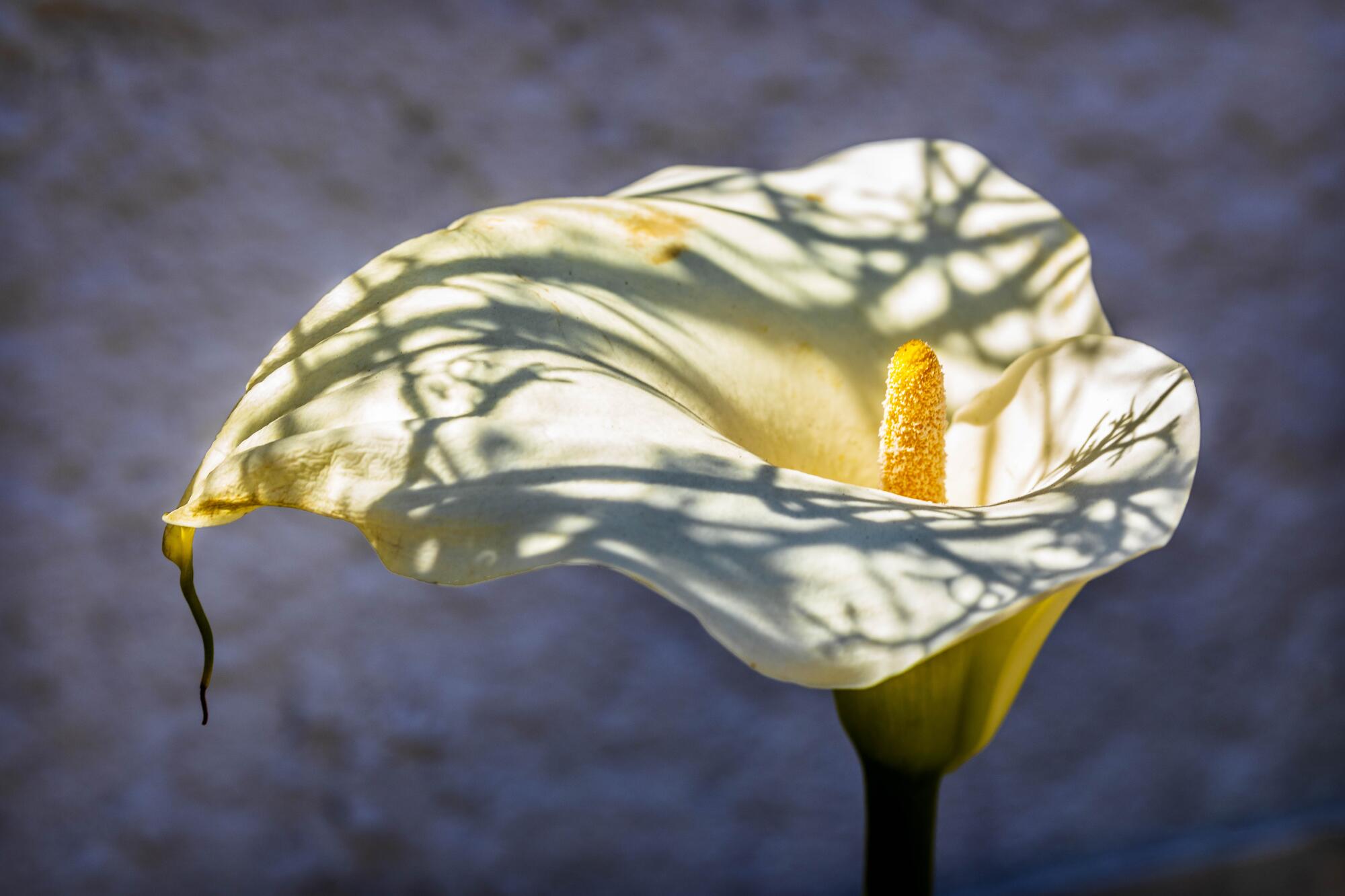
“My grandmother grew a few succulents — agaves, jade and aloe — but she didn’t have all the variety of succulents you see here today. I was always familiar with succulents because she grew them and then one day I saw a video on YouTube by [succulent designer] Laura Eubanks. I saw what she did, creating these beautiful gardens with succulents, and it really encouraged me to become more creative. She was so free in working with the succulents. There weren’t any limitations, and because I’m an artist working with plants, I really connected to that.
Native milkweed plants — the kind good for butterflies — are coming out of dormancy and starting to sprout, so be patient. Southern California gardeners should be able to buy narrow-leaf milkweed and perhaps a few other less-well-known native milkweeds starting in mid-April.
“During my studies, I also walked around the gardens at the Natural History Museum [of Los Angeles County] to get ideas and observe how the plants grow together. I met a lady who worked there as a volunteer and she was just so excited talking about how we live in a Mediterranean climate here on the coast. People always identify this as being a dry, desert climate, but at that moment, I learned that no, we aren’t a desert along the coast. Maybe inland, but here we’re a Mediterranean climate, and again, it was confirmation for me to go out and explore.
“It’s like my garden. What people will see is a mix of native plants, succulents and those California-friendly Mediterranean plants, and I say that because not all Mediterranean plants are California-friendly. The plants I grow are noninvasive and grow well with California native plants. An example is moonshine yarrow [Achillea ‘Moonshine’ — a hybrid introduced in England] growing near bee’s bliss sage, or sweet lavender and rosemary growing near a native buckwheat and hummingbird sage.
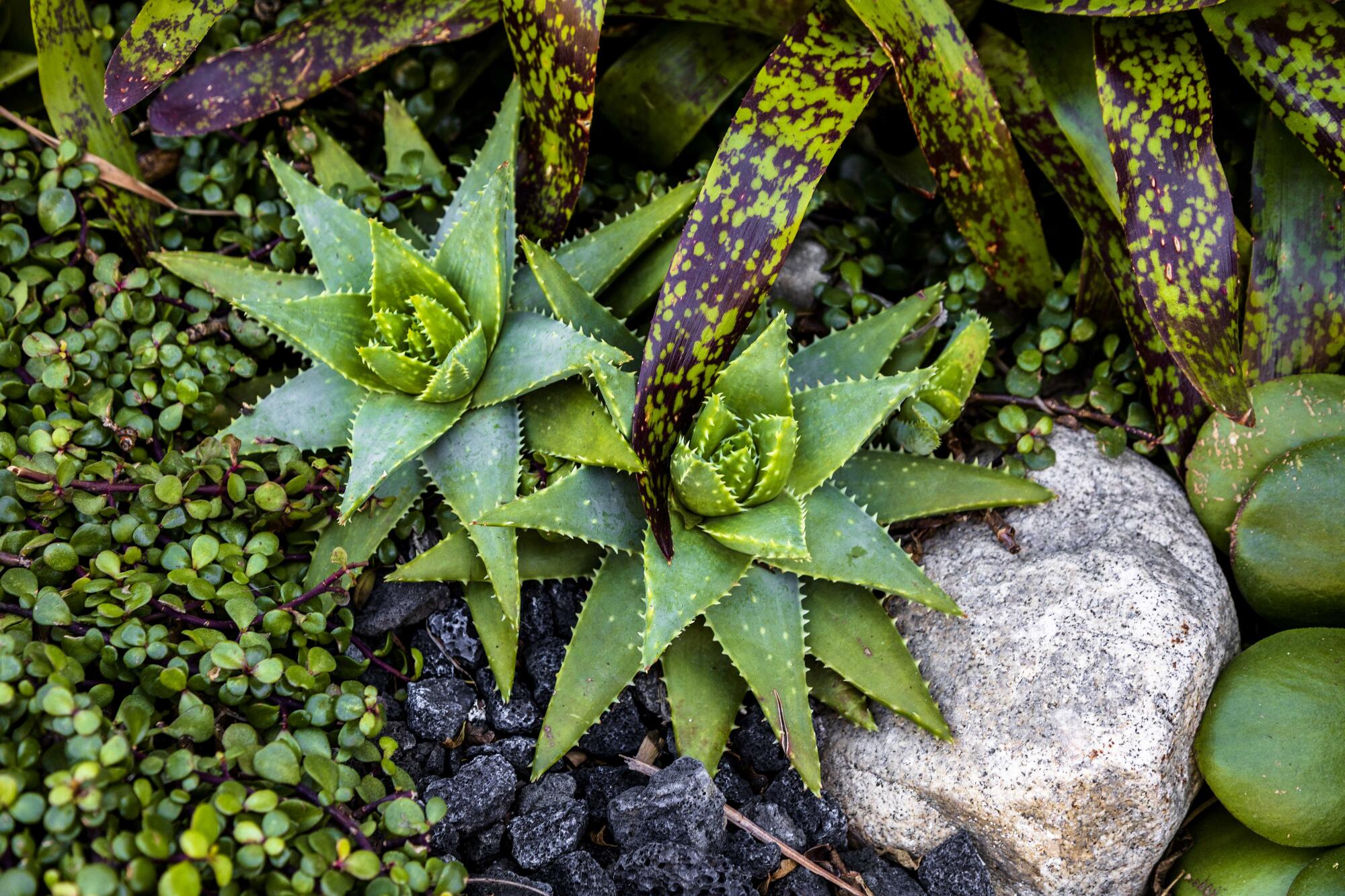
“Lavender is one of my favorite plants in the whole wide world, and I don’t think there’s anything wrong with that. I don’t want to not experience lavender because it’s a non-native plant. As long as I do as much study and research as I can, if a plant is not invasive and it’s California-friendly, then I’m with the group that says, ‘I’m OK with that.’ I promote natives but also succulents because not everyone appreciates native plants. So I make my succulent gardens but I always try to introduce those native host plants for pollinators too. The bees and butterflies will appreciate nectar flowers like lavender but they need the native host plants to feed their young, like native milkweed for monarchs. So I always try to incorporate some native plants to create habitat and help bring people along [to appreciate natives].”
Her motto: ‘Plants belong to all of us’
“When I’m designing, this is what I think: A garden is an opportunity for people of different backgrounds to come together and just learn about each other. It’s a way to connect with people and break down barriers, because plants are something we all have in common. We all have to eat, and most people love beautiful things and a lot of people enjoy pollinators — they enjoy seeing the hummingbirds and butterflies. So if you’re an introvert or just need a way to have a conversation, you know you can always talk about plants.’
Drought-resistant plants like hummingbird sage and rosemary are the ideal addition to Southern California gardens.
“One of my goals is to help people understand that they can do it wherever they are, even if it’s just a little raised garden bed or containers. Sometimes people are intimidated by gardening. They think, ‘I can’t grow that, it’s too hard, you have to know certain stuff,’ blah blah blah, but plants belong to all of us. Whatever socioeconomic background you have doesn’t matter. Plants belong to everyone, and gardens are one way to express that, so why would you be intimidated about something that’s good and belongs to everybody?
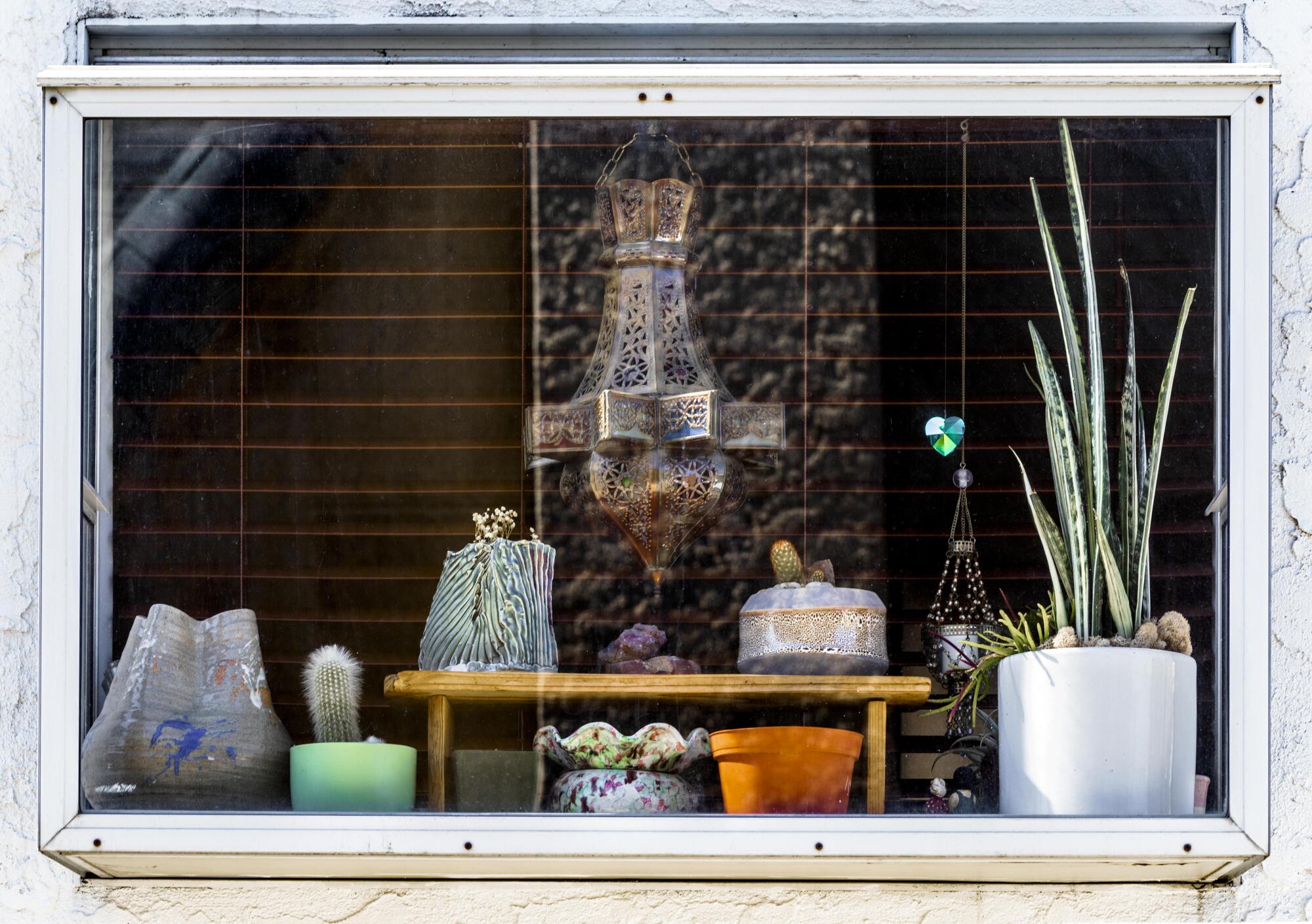
“If you are interested in reaching out, even just to family, a garden is the perfect place to gather and communicate. It’s also an opportunity to teach. It’s what I do when I have my [personal] garden tour; I am a teacher and people learn. They take the information back to their families and neighborhoods and they communicate, and that lets me know that I did my job.
“I think it’s awesome for people to come out and see my garden. It’s not about me, it’s about what I’m doing and what the impacts are for our community. I want to play my part in the whole environmental conservation movement, and, hopefully, I can inspire people to think in the same way.”
More to Read
Sign up for The Wild
We’ll help you find the best places to hike, bike and run, as well as the perfect silent spots for meditation and yoga.
You may occasionally receive promotional content from the Los Angeles Times.
